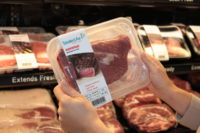Air-Chill Chicken Takes Flight
By Shonda Dudlicek
New niche could someday become industry standard, insiders claim.
Do consumers want more from their chicken, or are they happy with what they pluck from their grocer’s poultry case? Air-chilled chicken, the newest niche in the poultry arena, is slowly catching on in the United States.
Between the two air-chilled chicken processors, the product is sold nationwide, and a third company will being selling the chicken, which requires processors to completely rethink, rebuild, and restructure the traditional way of making chicken.
But those who sell air-chilled chicken say taking the bird out of the water lends itself to a more flavorful chicken.
“We stand behind flavor as the main differentiating point. You simply have not had chicken or can possibly understand how it’s supposed to taste until you’ve had air-chilled chicken,” says Erik Monson, vice president of sales and marketing at MBA Poultry, Tecumseh, NE.
Air-chilled chicken has been available in Western Europe for more than 45 years, and MBA Poultry was the first processor to bring that process to the United States in 1999.
Points of difference
During the traditional water-chilling process, chickens are slaughtered, cleaned, inspected, and the carcasses are immersed in often-chlorinated water below 40Þ F. The chickens are moved by paddles through the chill tank from 45 minutes to an hour to bring down their internal temperature to 40Þ F. After the optimum temperature is reached, the birds are pushed out of the tank and onto a shake table — and then to a drip line to shed excess water that was absorbed during the cooling process. Finally, the chickens are either packed whole or cut up into pieces.
In air chilling, chickens are suspended or sent by conveyor through two large chilling chambers and blasted with icy air. The first chamber reduces about 75 percent of the bird’s heat. The second chamber balances the 32Þ F- to 34Þ F-degree range.
A study by the University of Nebraska relays that air-chilled chicken have bacteria counts up to 80-percent lower than water-chilled chickens, extending its shelf life. Water-chilled chicken has whiter skin and a juicier flesh; air-chilled chicken has a creamy-looking skin and firmer texture and shrinks less when cooked. Both chickens contain the same nutritional value.
But some industry experts think air-chilled chicken won’t evolve beyond a niche market.
“The entire industry is set up for water chilling, and water chilling is known to be very effective,” says Richard Lobb, director of communications at the Washington, D.C.-based National Chicken Council. “I’ve never had a consumer call up and say ‘Where can I get this air-chilled chicken?’ I just don’t think people look at chicken in that way. They’re very happy with the product that they’ve got. They’re eating more and more of it almost every year, and we’re just rolling right along.”
With the low-carb diet craze, meat consumption has risen dramatically in the last couple of years. Between supermarket purchases and restaurant dining, Americans consume chicken about five times in a two-week period. The average American eats more than 81 pounds of chicken annually, and the NCC projects that number will rise to almost 88 pounds per capita in 2005.
Companies like MBA Poultry, with its Smart Chicken line, see air-chilled chicken as the future. “We’re not talking about Atkins or other fads that are here for a few months or years. Air chill will define the future of food items where entire industries can be changed because the right benefits are applied to existing products to drive the maximum value to the consumer,” Monson says.
Besides selling higher-priced product, air-chilled chicken makers face the challenge of educating consumers to a new way of thinking about fowl.
“Anytime a new concept is introduced, it takes a lot of trial and error to reach the right point of communication at retail. It goes well beyond point-of-sale and packaging to develop systems that you can rely on in getting air chill awareness and understanding,” Monson says. “Once you find the right approach and get the clients, our retailers, to buy in to your processes, then you are demonstrating the most valuable points of differentiation and quality that any food item can present to the consumer. It’s just a tough growth curve to manage and always challenging to communicate the story and message in the proper way.”
Consumers clamor for product
Charlie Moore, vice president of sales and marketing at Denver-based Maverick Ranch Natural Meats, says consumers are clamoring for his family business’ air-chilled chicken. “Consumer acceptance is very high. I’ve yet to receive even one consumer complaint on our free-range, air-chilled chicken. Most consumers claim it’s simply the finest-tasting and juiciest chicken they’ve ever eaten. They immediately recognize there is a difference, that it has exceptional palatability. The accolades from our high-end white tablecloth restaurant chefs are second to none,” he says.
Moore says air-chilled chicken is more moist, “even compared to chicken that’s been enhanced or pumped with sodium phosphate and water.” Citing the University of Nebraska study, Moore says Maverick Ranch air-chilled products are yielding an additional two to three days shelf life compared to water-chilled chicken.
“From a retailers’ perspective, this can really affect the bottom line by reducing shrink considerably. Because our product is both air-chilled and free-range natural, it has a higher retail ring and gross margin dollars. Because of all the additional product features, most consumers do not seem to be too concerned with the higher price,” Moore says.
Monson agrees. “Once you bite into air-chilled chicken, you have a superior eating experience every time.”
Both Monson and Moore say their companies have received many unsolicited testimonials praising the quality of the product and the message. MBA Poultry’s Smart Chicken brand has grown in the double digits in the past three years, Monson says. “It’s amazing how customers react. They turn into the most loyal buyers of added value that one could imagine.”
Lobb, however, is skeptical. “If you do a blind taste test — and this has been shown again and again and again — people really can’t tell the difference between real premium, upscale brand and regular and what is referred to as supermarket chicken,” he says. “People are pretty happy with the product they’ve got, and they really don’t see the necessity in paying extra. And in having paid extra they try and persuade themselves that it’s better. If you put a blindfold on them they really can’t tell the difference.”
MBA Poultry sells packs of wing, white, and dark meat. Combo packs include whole fryers and boneless, skinless breasts. Sampler packs have split breasts with rib meat, drumsticks, thighs, wings, tenderloins, and boneless skinless breasts. A Smart Chicken sausage variety pack has five links each of Italian, Andouille, Garlic and Herb, and Spinach and Feta.
MBA’s products are sold on its Web site and are distributed to more than 2,500 retailers in 41 states. Some of these include Dillon’s, Hy-Vee, Safeway, Lund’s/Byerly’s, Coborn’s, Andronico’s, Harris Teeter, Publix, HEB, and Big Y, plus retail clients through AWG in Kansas City, Springfield, and Oklahoma. Key distributors are Affiliated Foods, J&B Wholesale in Minnesota, and Nash Finch and MPI in Wisconsin.
Maverick Ranch produces chef-prepared, premium-quality fresh oven-ready entrées like chicken kabobs, stuffed chicken breast with cranberry walnut stuffing, and whole stuffed roasting chickens. These are distributed case ready with a 14-day shelf life. The company’s newest offering is free-range, air-chilled barbecue rotisserie chicken. Retailers carrying Maverick Ranch products include Omalia’s, Kroger, Publix, Andronico’s, Nugget Markets, Central Market, Albertsons, Piggly Wiggly, Big Y, Genuardi’s, Dillons, Hy-Vee, Wild Oats, Farm Fresh, Cub Foods and Vitamin Cottage.
And air-chilled chicken products may begin sharing space in the supermarket as other poultry companies break into the market. Fredericksburg, PA-based Bell & Evans plans to offer air-chilled chicken this spring.
The future
“The future for air-chilled chicken is very strong,” Moore says. “Currently, two other mid-scale, truly natural chicken companies are installing air-chilled systems. Obviously, they wouldn’t be spending millions of dollars in capital improvements if they didn’t see a competitive advantage in air chilled. I think you’ll eventually see the majority of premium natural/organic chicken processors utilizing the air-chilled process.”
Lobb says the future of poultry industry lies in both enhanced products and commodity chicken. “On one hand the supermarkets demand what is basically a commodity chicken, and tons and tons and tons of it. They sell chicken on a special quite frequently to bring people into the store, and supermarkets continually look to our industry to provide that type of product. On the other hand, we are providing more and more prepared products, things that are either enhanced, which is a moisture product. They’re also marinated to give it more flavor, and they’re ready to cook. And then you’ve got plenty of ready-to- eat, heat-and-serve, those kinds of products, and those are popping up all over the store.
“The frozen food aisle is bulging with all types of food now, buffalo wings, all sorts of things in the stand-up, resealable, plastic bags, and then over in the deli – wow, forget it – over in the deli we’re overrunning them with rotisserie and wings and fried chicken and all kinds of stuff like that,” Lobb adds.
Monson says the greatest challenges facing air-chilled chicken processors are managing the new technology and changing the commodity mindset. “I think we’ll see the industry slowly change toward this technology. We have proven that the consumer will pay for the added production cost and that the business model can work. It will take some time, though, as the industry has a commodity mindset and gets billions in revenue annually for chicken values.”
As pioneers in America’s air-chilled chicken industry, MBA Poultry struggled to harness the discipline of air chilling.
“Now that we have done the diligence and learned from failures, there is a true science to air chill that can yield far more than flavor. You can realize greater safety, better texture along with waste management and environmental benefits,” Monson says.
“The greatest challenge for the industry will be managing the technology. It is not easy, and I can tell you that we struggled for a long time. Using air to manage bird temperature can be difficult and there are a million intricacies that go into the process. I’m a believer that the American consumer will continue to be discerning and demand the change in technology as we look into the future,” Monson adds.
Lobb sees momentum in value-added products and doesn’t envision air-chilled chicken moving beyond a niche.
“There are an increasing number of niche markets in food marketing of all types. There’s a place for practically everything. If you can find and exploit that kind of niche, more power to you. But I think people tend to think of chicken as a staple and in most cases people are not prepared to pay almost double for the same thing.”
Monson, however, is more optimistic. “What was once laughed at may become the standard in the broiler industry,” he says. NP
Shonda Dudlicek is a veteran food industry freelance writer in the Chicago area.




Report Abusive Comment